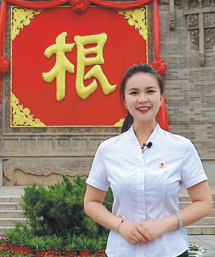Guiding Chinese people in search of their family roots
Updated: 2022-06-10

Fan Yanjun is among the most popular guides in Dahuaishu township. [Photo by Li Lian for China Daily]
For tourists to a place of historical interest like Dahuaishu township in Hongtong county, Shanxi province, a well-informed tour guide is of great help.
Fan Yanjun, 26, is one such guide. When serving tourists at this worshipped destination, she can bring an impressive experience by introducing accurate history and vivid stories.
Dahuaishu, which means Big Locust Tree, is the place where many Chinese people inside and outside the country believe their ancestors emigrated from during the Ming Dynasty (1368-1644).
According to historical records, for 50 years in the early Ming Dynasty, there were 18 large population movements from Dahuaishu township to more than 500 counties across 18 provinces.
These emigrants moved further across the world in the six centuries that followed.
This historical background has made Dahuaishu one of the most popular destinations in China for tourists who want to seek their ancestral roots, according to Fan.
On one day in early summer, Fan showed visitors to the landmark big locust tree in front of the gate of the Dahuaishu Ancestors Memorial Garden. She explained the history of the ancestral hometown of many Chinese people with a household folk song:
"Where were our ancestors from?
It's the Big Locust Tree in Hongtong.
What is the name of our ancestral residence?
It's the Old Stork Nest under the Big Locust Tree."
She also told visitors that historical evidence can be found in many family genealogy books and tombstone inscriptions throughout the country.
When talking about the importance of Dahuaishu in the history of many Chinese families, Fan was challenged by a tourist surnamed Zhao.
While recognizing the Ming Dynasty immigration movements, Zhao said it might be an exaggeration to say that Dahuaishu is the major ancestral root of many families.
"My family's ancestral root, for instance, is in Zhaocheng, another township in Hongtong county, and the history can be traced back to 2,500 years ago," Zhao said. He explained that Zhaocheng used to be the fief of the ancient Zhao family.
Fan said she agreed with Zhao's presumption, adding that "it's always a pleasant experience to interact with tourists and it's also a good chance to learn from them".
Fan is a native of Hongtong and has a strong attachment to the historical township of Dahuaishu.
"The place is full of history and full of stories," she said, adding that introducing tourist attractions with accurate history and vivid stories is the basic requirement for a qualified tour guide.
"For this purpose, we need to learn constantly," Fan said. "We can learn from books. But it's an even better opportunity to learn from experts and tourists, who always have something inspiring to share with you."
Fan began to work as a tour guide in Dahuaishu in 2017. Since then, she has served more than 2,000 visits by tourist groups or individuals. Her colleagues said she is among the most popular tour guides in Dahuaishu because of her professionalism.
Over the past few years, Fan has traveled to many regions in China to promote the attractions of Dahuaishu. "I hope the history and culture of Dahuaishu can be known to more people," she said.
Wu Jia contributed to this story.



